With the increasing complexities of the network environment currently experienced in organizations, users are faced with unique challenges in securing their organizations’ networks without necessarily compromising the availability of various organizational resources.
Meet the Secure Access Service Edge (SASE), a revolutionary network architecture that is making the world of difference. Several SASE trends are in the process of defining how companies should address networking and security issues in the contemporary environment since they provide an ideal one-stop solution to various connectivity concerns.
Definition of Secure Access Service Edge (SASE)
To those of you who have heard about SASE or Secure Access Service Edge (if you have not, it is okay, let me tell you that SASE is not just the new ‘it’ thing in IT).
It is an umbrella solution that bundles network and security services into one efficient and optimally delivered in the cloud model.
Current SASE trends show a trend in transforming the traditional heavy hardware integrated security solutions to more agile, elastic and customer orientation.
Knowing the risks associated with public Wi-Fi can help in understanding the future trends in Secure Access Service Edge can help in grasping the shift towards more integrated network and security services.
SASE as a Network Architecture
Secure Access Service Edge (SASE) is a cloud-native model that integrates network and security services into one efficient solution.
It combines WAN capabilities with cloud-native security functions, allowing secure and efficient access to resources regardless of the clients’ location, applications, or data.
Network solutions should not be separated from the security solutions
The attractiveness of attending SASE is that we can do it as one all-encompassing concept and system, which aligns with the future trends in Secure Access Service Edge.
Organizations are highly likely to reap improved performance, security, and the general ability to manage the complex IT environments — especially considering networking and security as interrelated components.
Brief history on the evolution of SASE
SASE was coined by Gartner analysts Neil MacDonald and Joe Skorupa in July 2019. It gained accelerated adoption in 2020 due to the COVID-19 pandemic, which emphasized the need for secure remote work solutions.
By 2021, SASE had further refined with the introduction of Secure Service Edge (SSE). Its popularity continued to grow in 2022 and 2023, and it is expected to sustain growth with advancements in AI and machine learning.
Here’s a brief history of SASE from its early days to the present:
2019: Origin of Secure Access Service Edge
- SASE term was created by the Gartner analysts Neil MacDonald and Joe Skorupa in the hype cycle of networking equipment in July 2019.
- This helped them identify new possibilities of use and purchasing in the context of digital transformation, targeting the need for cooperation in the sphere of network protection.
2020: Accelerated Adoption
- The COVID-19 situation forced organizations to adopt work from home concept rapidly, and focused on the flaws of conventional networking and security paradigms
- Companies started adopting SASE as a means of establishing communication between the dispersed users and devices that require secure access to the cloud services.
2021: Refinement and Adoption
- Gartner divided a portion of the SASE architecture known as Secure Service Edge (SSE) that includes security services that are deployable through the networking services like SD WAN.
- Leading technology vendors including Cisco, Palo Alto Networks, and Zscaler, introduced their SASE solutions, thus creating more awareness.
2022-2023: The Popularisation and Expansion
- Secure Access Service Edge became popular having organizations appreciate that it can effectively help manage and secure networks in a world where cloud is the new reality.
- The SASE market worldwide was estimated at around USD 1. 68 billion in 2023 and further expected to rise up to around USD 20. 30 billion by 2031 at a Compound Annual Growth Rate of 36 percent. 4% to the period of 2024 to 2031
2024: Sustained New and Growth
- The SASE solutions are still continually being developed to add new features to achieve better and enhanced performance as well as security; these are artificial intelligence and machine learning.
- The adoption of Secure Access Service Edge (SASE) is also foreseen to increase as organizations continue to realize that it can enable the key driving force of digitization-projects and protect the diverse users and endpoint devices. For best practices in cybersecurity, refer to this comprehensive cybersecurity guide.
The introduction of a new approach to networking and security called SASE has been catalyzed by the increase of users’ reliance on cloud solutions and mobile devices, as well as the demand for remote secure access.
Thus, SASE remains a critical component of the future of network security as more organizations adopt the concept.

- Lightning-fast speeds to browse without lag
- Servers in 105+ countries around the globe
- Military-grade security to stay safe online
- Try it risk-free with its money-back guarantee
- Native apps for all major devices
The Growing Adoption of SASE
Rise of Cloud Computing and Remote Work
The availability of cloud services and the new central tendency toward working from home have amplified Secure Access Service Edge usage.
These trends have proved the measures of the conventional perimeter security model and incentivized SASE Market Growth, which is cloud-native and distributed.
Do You Know?
Market statistics and growth trends
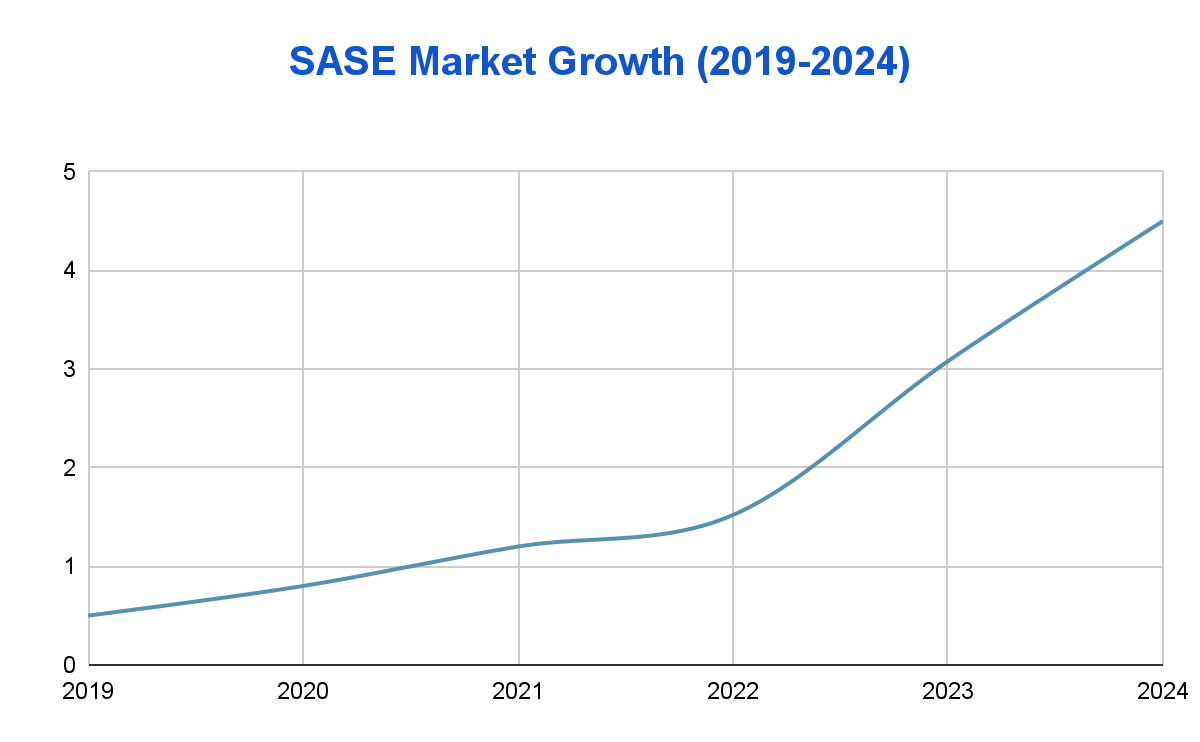
The SASE market is experiencing explosive growth. According to recent reports, the global SASE market growth is expected to grow from $1.2 billion in 2021 to $4.1 billion by 2026, representing a compound annual growth rate (CAGR) of 26.4%.
Factors driving growth in SASE adoption
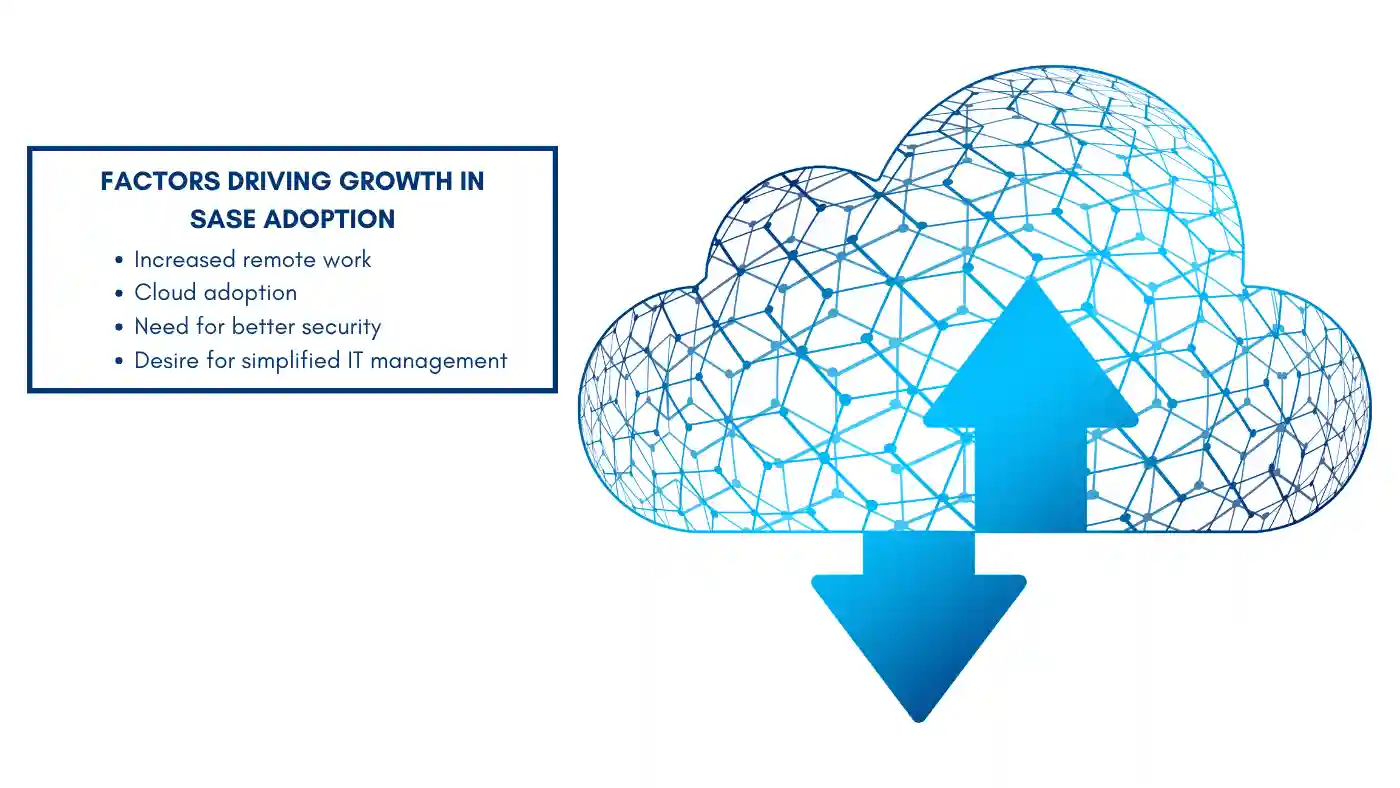
Several factors are driving SASE adoption, including increased remote work, cloud adoption, the need for better security, and the desire for simplified IT management.
SASE provides a unified approach to networking and security, making it easier for organizations to manage complex IT environments.
SASE in various sectors
SASE is particularly beneficial in sectors that handle confidential information, such as healthcare, finance, and education.
Healthcare organizations use SASE for secure telemedicine, financial institutions for transaction protection, and universities to secure distance learning infrastructure.
-
Healthcare, finance, and education
It is worth mentioning that the tendencies related to SASE are even more significant in industries that deal with strictly confidential information.
A lot of healthcare organizations are utilizing SASE to protect patients’ information while allowing for telemedicine.
SASE is being applied by financial establishments for shielding of transactions and meeting regulatory necessities. Several universities across the United States are deploying SASE to protect the distance learning infrastructure.
-
SASE and large organizations
Earlier, SASE was mainly implemented in large enterprises, but recently, especially in the past year, more and more SMBs have implemented SASE.
What’s important for SMBs is that implementing SASE results in a robust security level that is typically available at the enterprise level, but it does not require huge in-house IT personnel. For insights on securing cloud computing environments, this guide offers valuable strategies.
Current SASE market dynamics reveal quite large and mixed trends in its market acceptance across sectors. Here are the key highlights:
SASE Market Growth
The overall SASE market was valued about USD 1. To be precise, the Artificial Intelligence industry amounted to approximately USD 68 Billion in 2023 and is anticipated to achieve USD 20. 10 billion by 2031 at a CAGR of 36%. 4% for the total period of 2024 to 2031.
This kind of growth rate depicts the need to adopt holistic security products since organizations are migrating towards the cloud and remote working models.
Key Drivers of SASE Adoption
Shift to Cloud Services: Due to the advancement in remote working and actually forced mass remote working after COVID-19, organizations need good security architecture. SASE brings in a singular model of networking and security functions that simplifies how the enterprise manages and secures the data traffic in the distributed setup.
Increased Cybersecurity Complexity: Since enterprises are implementing various security solutions, there is a growing need for a single solution such as SASE.
Due to it consolidating many technologies into a single service, it makes cybersecurity management an easier task since it cuts down on many risks brought about by cyber terrorism.
Sector-Specific Trends
Healthcare, Automotive, and Electronics: SASE is finding its way to industries like healthcare, automotive, electronics etc where strict levels of access to data are required. The need to safeguard patients’ details and ensure the safety of transactions has led to its integration in these sectors.
Government Initiatives: The governments are also applying pressure on companies to adopt sase to improve their security measures. For instance, United States’ Department of Defense is already adopting SASE frameworks in the protection of cloud connectivity and defense force networks.
Future Outlook
Continued Growth: Currently, the SASE market has been growing steadily as firms realize the need for security in network management.
The trends towards hybrid cloud systems and later the necessity in safe remote access are expected to add to SASE’s popularity in the next few years.
Future trends in Secure Access Service Edge are expected to reflect a healthy and growing market as organizations seek stronger protection amid the growing scale of digitalization and increased use of remote work.
The security of organizations across different sectors is incorporating the implementation of SASE solutions to enhance security policies.
Case Studies of SASE
A Global Retailer
Following is the case study of a global retailer In the light of According to recent experiences, the following case is prepared to illustrate the topic IN MC 102- Fundamentals of Management It is the case of a global retailer.
A massive retail chain started deploying SASE in order to protect all of its shops and warehouses around the world. It enabled a 40% reduction of the nature in the network and a further enhancement of cloud-based application’s performance.
A large healthcare provider
An example of the use of SASE in a healthcare environment is a regional healthcare system that wanted to provide secure telemedicine.
The participants mentioned that they recorded improvement on various parameters which included a 50 % reduction on connectivity problems as well as improved security on patient’s information.
SASE best practices
Key takeaways from these case studies include:Key takeaways from these case studies include:
- One of the most vital aspects that should be considered while implementing a new change is to do it in phases.
- Employee training as one of the basic requirements
- This value consists in understanding that the decision of who will be a provider of SASE is a crucial one.
Pro Tip
Key Technologies Shaping SASE
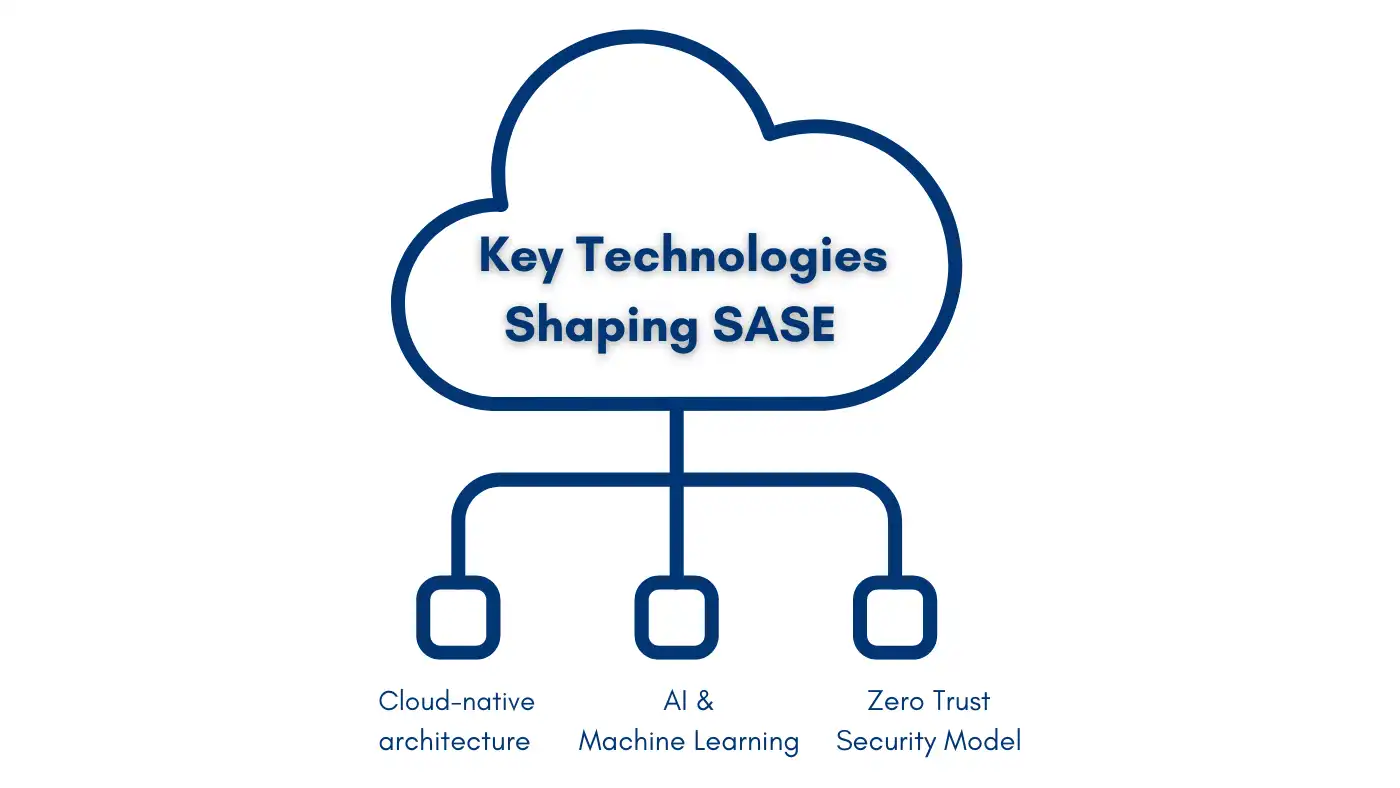
Key technologies shaping SASE include cloud-native architecture, artificial intelligence (AI), and machine learning (ML).
These technologies enable rapid updates, global availability, reduced hardware dependencies, and lower total cost of ownership.
AI and ML enhance proactive security measures through anomaly detection, threat prediction, and automated incident response.
Cloud-native architecture
- The relevance of scalability/generalizable and complex systems/solutions.
Future trends in Secure Access Service Edge indicate that cloud architectures are the way of the future. This aspect makes it possible for organizations to increase or decrease the size of its security and networking in correspondence to the need hence making it flexible.
- Benefits of cloud-native security and networking services
Cloud-native SASE solutions offer several advantages:
- Rapid updates and patches
- Global availability
- Reduced hardware dependencies
- Lower total cost of ownership
Artificial Intelligence and Machine Learning
- Role of AI/ML in proactive security measures
Another set of features revolves around Artificial Intelligence (AI) and/or Machine Learning (ML) that is already incorporated into SASE solutions. These technologies enable:
- Anomaly detection
- Threat prediction
- Security incidents auto response
- Improving the satisfaction of customers through use of automation
AI-driven SASE trends include:
- Intelligent traffic routing
- Automated policy enforcement
- Predictive performance optimization
The concept of Zero Trust Security Model
- Principles refer to Zero Trust mechanisms
SASE is composed of its foundational architecture, which is the Zero Trust model. It continuously represents the slogan “never trust, always verify” and presupposes verification of the user’s identity and his/her right to access the information within the company’s network, no matter where he or she is.
- Incorporation of Zero Trust into SASE models
SASE trends show increasing integration of Zero Trust principles:SASE trends show increasing integration of Zero Trust principles:
- Continuous authentication
- Least privilege access
- Microsegmentation of networks

Uninterrupted, high-speed browsing, zero logs so your online activity is always private.
Over 7000 people checked out NordVPN in the last month
Do You Know?
The proposed plan has the following general objectives:
The first emerging concept is known as user experience, and it is one of the most critical SASE developments. SASE solutions are evolving to provide:
- Explaining why faster access to the resources would be in the best interest of the employees of the enterprise.
- Integration of various networks possible
- Creating security policies that are equally appropriate for implementation in all of the organizational units.
Secondly, SASE providers are increasingly adopting user-centric design principles:SASE providers are increasingly adopting user-centric design principles:
- Intuitive interfaces
- Self-service portals
- Personalized security policies
Integration with SD-WAN
- SD-WAN and SASE: Why they must go together
It is quite logical to assume that SASE and SD-WAN go hand in hand. SD-WAN offers the capability choices for improved ways of routing and the connection of the network, while the SASE fortifies network security. This combination is inaugurating the dominating trend in network architecture.
Advantages of implementing an interdisciplinary strategy at the enterprise level
Integrating SD-WAN with SASE offers several advantages, including improved application performance, better network visibility, simplified management of networking and security, and enhanced overall security posture.
This combination provides a comprehensive solution for modern network architecture.
Heightened Concerns with the Protection of Data and Regulatie
- Directions in legislations that may impact SASE solutions
SASE trends are being shaped by evolving data privacy regulations:
- GDPR in Europe
- CCPA in California
- Rules that apply to a particular segment such as the HIPAA rules for the healthcare sector.
How SASE can assist in compliance efforts
SASE solutions are evolving to help organizations meet compliance requirements:
- Data loss prevention (DLP) features vary by product; however, they are commonly embedded in programs that provide active threat protection for portable devices and removable media.
- Data in transit and data at rest must also be encrypted
- Sophisticated fundamental logging and reporting facilities
Pro Tip
During the comparison of SASE solutions, prefer the products that have the compliance tools that will suit the industry’s needs.
Challenges and Considerations
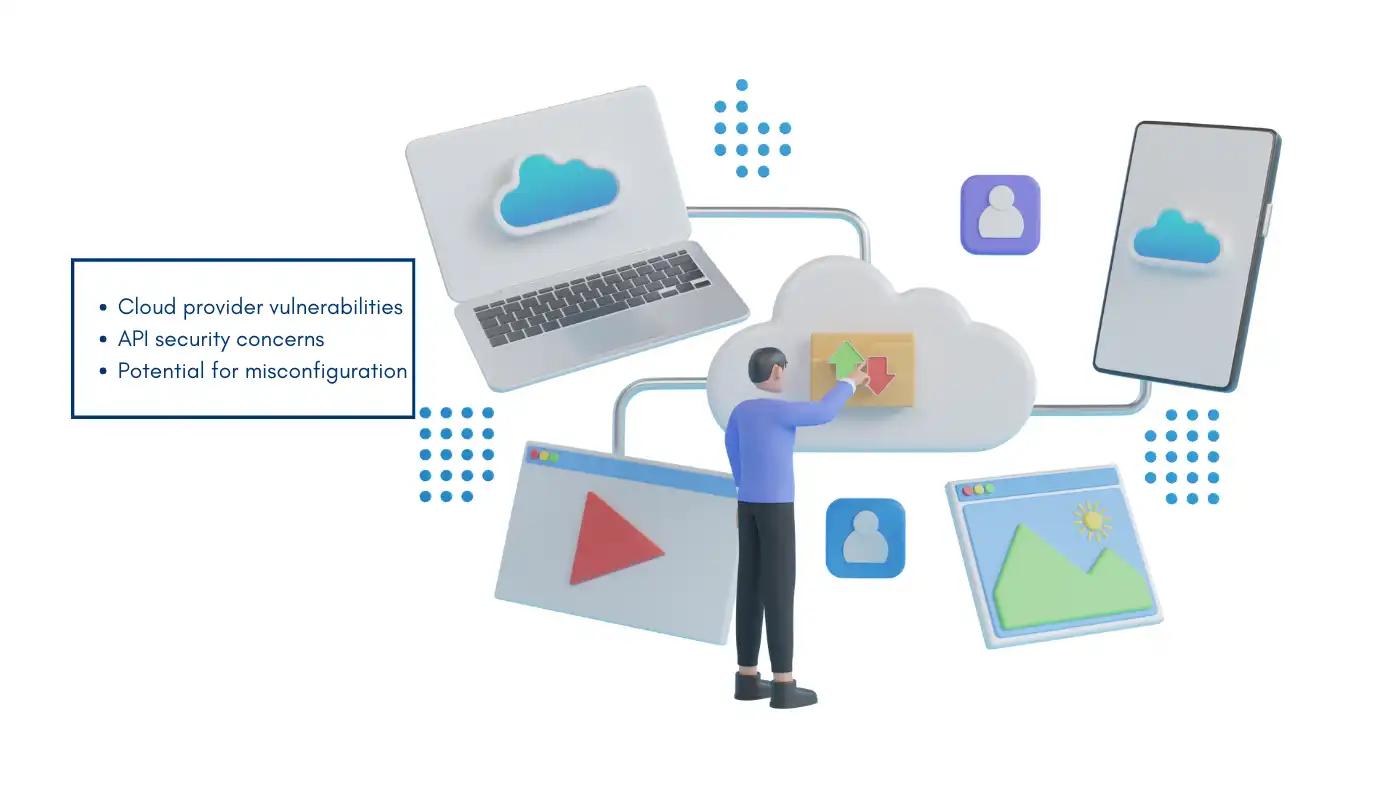
Challenges in adopting SASE include potential risks such as cloud provider vulnerabilities, API security concerns, and the possibility of misconfiguration.
Organizations also face resistance to change, integration issues with legacy systems, and the need for regular security audits. Selecting the right vendor is crucial to addressing these challenges.
Security Threats of SASE Adoption
- Upcoming risks in SASE designs
While SASE offers enhanced security, it’s not without risks:While SASE offers enhanced security, it’s not without risks:
- Cloud provider vulnerabilities
- API security concerns
- Potential for misconfiguration
The measures for contending with threats to security
To address these risks, organizations should:
- It is recommended that the security is audited on a regular basis.
- Conduct thorough Access Control.
- Always remain informed about the modern tendencies and recommendations concerning SASE.
Transforming from Traditional Security Paradigms
- Antecedents to change and adoption resistance
The transformation to SASE normally entails a lot of shifts in organizational structures and cultural behaviors. Common challenges include:
- New tools implementation in an organization, resistance from the employees
- There is always the issue of the integration of the legacy systems with a new system.
- Shortcomings of IT personnel and teams
Sluggish performance during migration to SASE
Technical hurdles in SASE adoption may include:
- Data migration complexities
- The integration of the APT with these other technologies would be:
- Continuing the protection: the challenge that arises when switching from one security system to another
Vendor Selection and Market Fragmentation
- The significance of a vendor in SASE adoption
Hence, selecting the right vendor has become critical with the increasing popularity of the SASE market. Factors to consider include:
- The credibility of the vendor as well as its financial position
- A wide range of service line areas and depth of such assistance engagements
- Compatibility with other systems of a company.
Assessing a number of options on the market
However, there is a growing number of vendors in the SASE market, which complicates the process by which companies select the most appropriate vendor. Organizations should:
- Define clear requirements
- It can also be pointed out that proof-of-concept is conducted thoroughly.
- Think big, with strategic planning horizons and standpoints.
Do You Know?
Future Developments in SASE
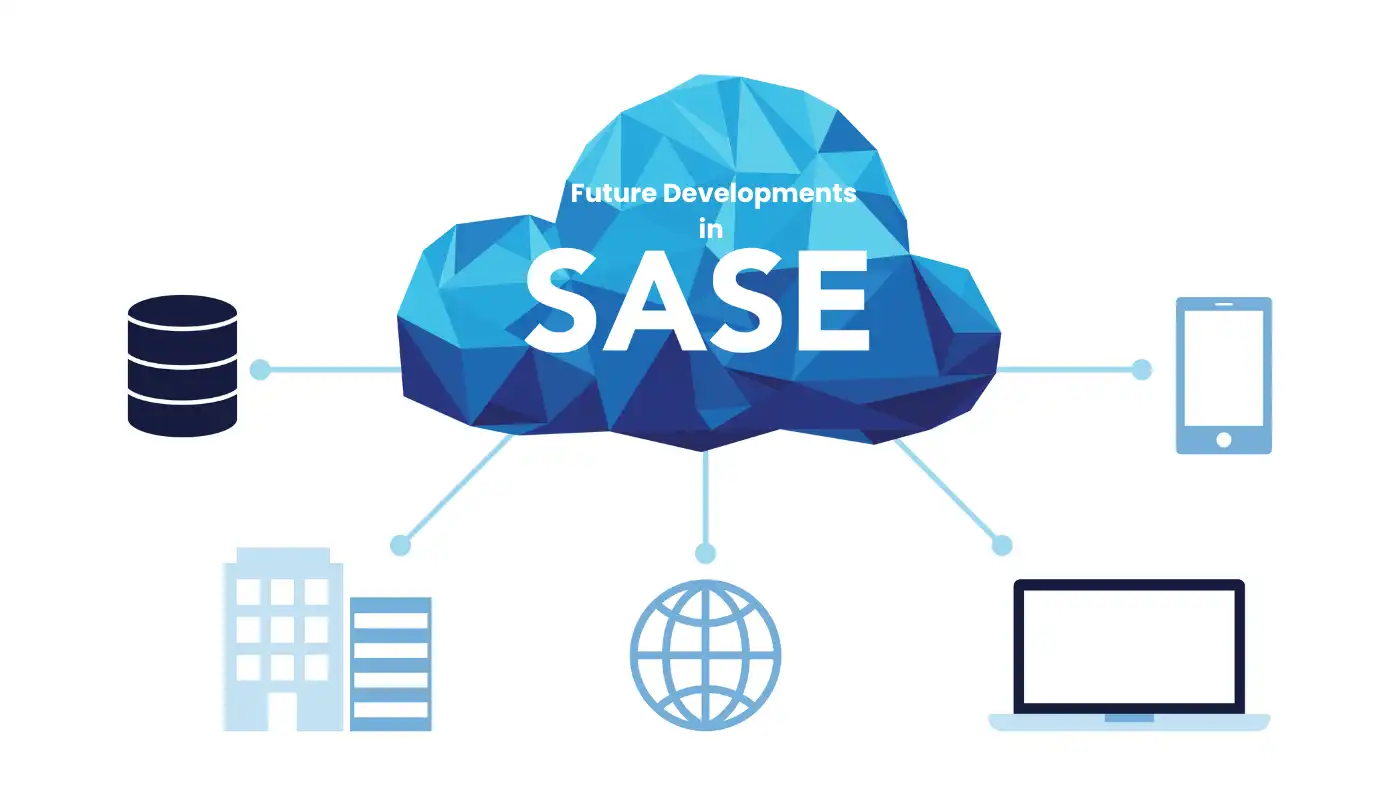
SASE is expected to continue evolving with technological advancements such as 5G networks, edge computing, advanced AI-integrated security systems.
Quantum-resistant encryption, blockchain-based identity management, and advanced biometric authentication.
The market for SASE is projected to grow significantly as organizations seek stronger protection in the digital age.
Forecasts for the next 3-5 years
- Improvement of technology as well as infrastructure.
Looking ahead, SASE trends suggest several technological advancements: Looking ahead, SASE trends suggest several technological advancements:
- 5G Networks Connection
- New capabilities in regard to edge computing
- Advanced AI integrated security systems
- Expectations in user adoption and market size
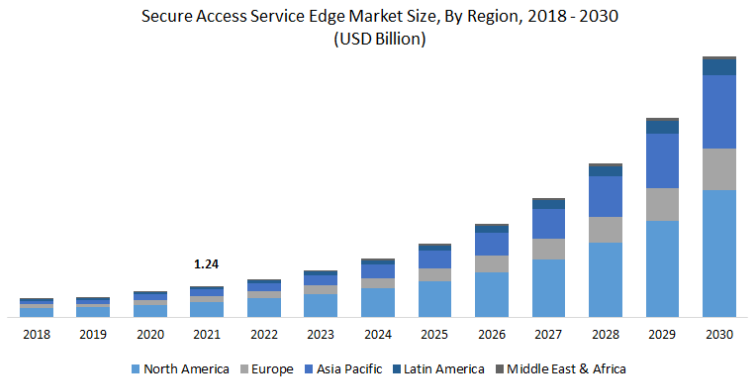
Experts predict continued rapid growth in SASE adoption:
- Increased adoption among SMBs
- Expansion into new industries
- Growth in emerging markets
Innovations on the Horizon
Emerging technologies that could shape future SASE trends include:
- Quantum-resistant encryption
- Blockchain-based identity management
- Advanced biometric authentication
Evolving business models and delivery methods
SASE providers are likely to innovate in how they deliver and price their services:
- Consumption-based pricing models
- Customizable service bundles
- Integration with other managed services
The Role of Ecosystem Partnerships
- Collaboration among vendors, service providers, and enterprises
The future of SASE will likely involve increased collaboration:
- Partnerships between SASE vendors and cloud providers
- Integration with industry-specific solutions
- Joint development of standards and best practices
- Synergies created through partnerships in SASE deployments
These partnerships could lead to:
- More comprehensive SASE offerings
- Improved interoperability between solutions
- Faster innovation and feature development
Pro Tip
Conclusion
In our previous discussions, we have discussed several trends in SASE (Secure Access Service Edge). These are how fast the SASE market is growing, new technologies like AI and Zero Trust, easier for users, rules, and SASE pros and cons for selection and usage.
From our analysis, the future appears bright and as more growth is projected the future ideals for SASE looks bright.
This means that as the business world discovers how SASE can serve its goals it will consequently be the leading method to provide network access.
If your company has not yet considered SASE, now is the right time to do so. Consider what your network and security requirements are, and determine whether SASE could meet them.
SASE is dynamic, and there is more to learn regarding trends and the best practices of applying this solution.
SASE is not just the new buzzword but the new model of network security which is revolutionizing the way by which corporations link and safeguard their assets.
If these following trends of the SASE are understood and implemented, the business is all set for success in our sophisticated digital realm.






